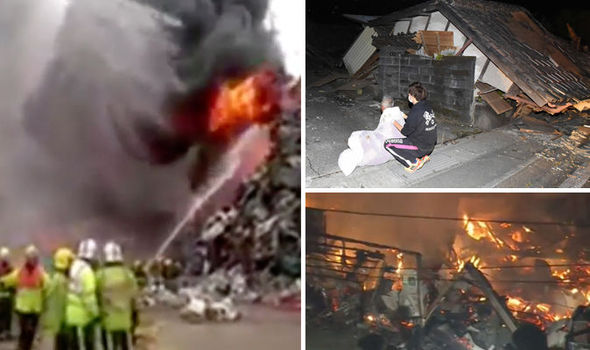Scientists fear ‘the Big One’ is COMING as FOUR major earthquakes strike in 48 hours

FEARS a catastrophic earthquake is building today grew after a fourth major tremor struck the same region in just 48 hours.
There have been three large earthquakes recorded in recent days, including a major one in southern Japan which destroyed buildings and left at least 45 people injured, after Myanmar was rocked on Wednesday.
Tremors were also felt as far as 500 miles away at the national park in India where the Royal couple Kate and William were visiting.
Yesterday, The Japanese Red Cross Kumamoto Hospital confirmed 45 were injured, including five with serious injuries after a quake of magnitude 6.2 to 6.5 and a series of strong aftershocks ripped through Kumamoto city.
Several buildings were damaged or destroyed and at least six people are believed to be trapped under homes in Mashiki. Local reports said one woman was rescued in a critical condition
Scientists say there has been an above average number of significant earthquakes across south Asia and the Pacific since the start of the year.
The increased frequency has sparked fears of a repeat of the Nepal quake of 2015, where 8,000 people died, or even worse.
Roger Bilham, seismologist of University of Colorado, said: "The current conditions might trigger at least four earthquakes greater than 8.0 in magnitude.
"And if they delay, the strain accumulated during the centuries provokes more catastrophic mega earthquakes."
Yesterday's quake in Japan was followed by a 5.9-magnitude earthquake which struck off the coast of the southern Philippines.
The earthquake happened at 2.20am (Singapore time) off Mindanao island.
Local authorities said there was no tsunami risk and that they had not received reports of casualties or damage.
In Japan, a number of buildings were destroyed by the powerful 6.4 magnitude quake.
Japan's Meteorological Agency said the epicentre was in the Mashiki town in the Kumamoto prefecture.
Officials said the region's nuclear facilities were not affected.
A 6 magnitude earthquake also hit yesterday off the coast of the Pacific island of Vanuatu, according to the United States Geological Survey (USGS).
It was 53 miles from town Port Orly and the fourth one this week in the immediate area, after a 6.4-strength tremor hit a week earlier.
Vanuatu is on the "Pacific Ring of Fire," one of the most seismic parts of the globe and known for its earthquakes and volcanoes.
Seismologists say the Himalayan region is overdue for a tremor stronger than Nepal's 7.9 strength quake last year.
Yesterday's quakes take the total to nine across Asia in a period of just over three and a half months — nearly three every month.
Just five days ago, on April 10, six people died in Pakistan when a 6.6-magnitude quake hit Kabul with aftershocks in India
Two days before, on April 8, there was a magnitude 4.2 earthquake in Nepal.
Nepal had suffered a larger 5.5 magnitude one on February 22.
A month before, on January 20, there was a 6.1-magnitude earthquake in China, and 16 days earlier 11 people died when a 6.7-magnitude earthquake hit Manipur in India.
India's disaster management experts from the Ministry of Home Affairs (MHA) said in January an 8.2 magnitude quake was due in the already ruptured Himalayan region.
The 2011 Sikkim earthquake created more rupturs in the Himalayas, on top of those caused by previous quakes, and scientists have feared the area is continually weakening with each new quake.
India's National Institute of Disaster Management (NIDM) says stress in the mountains of the north-east and the colliding of the Himalayan plate iand the Indo-Burmese plate in the to the puts the whole region on red alert.
Techtonic plates west of the Nepal earthquake are still locked and scientists fear this is another trigger waiting to go off.
A scientific study published in Nature Geoscience said the Nepal quake: "Failed to rupture the locked portions of the Himalayan thrust beneath and west of the Kathmandu basin because of some persistent barrier of mechanical and structural origin."
Stresses locked in this area could be released, potentially causing a massive quake.
BK Rastogi, director general of the Ahmedabad-based Institute of Seismological Research, said: "An earthquake of the same magnitude is overdue. That may happen either today or 50 years from now in the region of the Kashmir, Himachal, Punjab and Uttrakhand Himalyas. "Seismic gaps have been identified in these regions.
"The accumulation of stress is going on everywhere. But where it will reach the elastic limit, we don't know nor also when. But what we do know is that it is happening everywhere."
Политика конфиденциальности | Правила пользования сайтом









